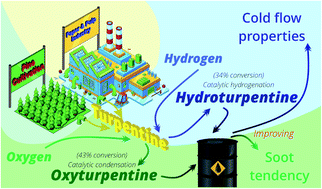Hydrogenated or oxyfunctionalized turpentine: options for automotive fuel components†
Abstract
Many concerns, such as economic and technical viability and social and ethical aspects, must be considered for a feedstock selection for advanced biofuels. Industrialized countries promote the use of industrial waste or by-products for this purpose. In particular, turpentine has several properties which make it an attractive source for biofuels, including its possible industrial waste origin. Nevertheless, turpentine has shown some disadvantages when blended directly with diesel, especially because it increases the sooting tendency. On the contrary, some derivatives of turpentine can be suitable for diesel blends. Thus, the evaluation of their properties is necessary. In the present work, the properties of hydrogenated and oxyfunctionalized turpentine have been analysed and compared with the purpose of elucidating their benefits and drawbacks in diesel fuel applications, using European standards as a reference. The results show a promising application of both hydroturpentine and oxyturpentine as diesel components. While hydroturpentine significantly improves the diesel cold flow properties, oxyturpentine noticeably reduces the sooting tendency.



 Please wait while we load your content...
Please wait while we load your content...